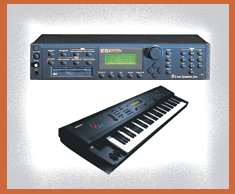2. A Brief History of Recording
4. A Brief History of Copyright
6. Organisations Protecting Copyright
9. Copyright Infringement (Examples)
10. Solutions (Sample Clearance)
I. Audio Examples of Legal Works and Copyright Infringements created Using Samples
II Explanation of the Main Components Used in the Construction of a Digital Sampler
III. World-wide Copyright Agencies
IV. Example lyrics from a musician who uses Samples
Table of Figures.
Fig.1. Block Diagram of a Digital Audio System
Fig.2. Diagram showing an Input Sine Wave and the Stepped Result of Sampling
Fig.3. Diagram Showing Flow of Funds Within the Music Industry
This dissertation examines the law of copyright to give an account of how it works and how artists are paid. It presents an analysis of the subject which is intended to act as a guide to potential and existing users of samplers and samples.
- The first section looks at what sampling is and how technology has developed to date.
- The second section deals with the details of the current law- the 1988 Copyright, Designs and Patents Act (UK). It also shows who investigates upon the artist's behalf and how much time and energy is put into this.
- The third section looks at how copyright affects 'sampling' (either from records or other copyright material), i.e. how much one must disguise a sample before the original artist/ copyright holder is entitled to royalties. Within this topic sample clearance is covered, i.e. who to talk to and how much one would pay to obtain permission to use a particular sample.
Copyright is a very complex and convoluted subject of which the basics are covered and simplified. The field of sampling is a relatively new and rapidly expanding area with precedents being set all the time, the law can be ambiguous so there is some confusion about what exactly is permitted. Where there are contradictions they are exposed, and where there is simply a lack of guidance a suggested ruling is indicated.
Musicians and technologists find themselves in a brave new world where sounds, text and video are woven into a complex multimedia environment where vast amounts of digital data can be transported across oceans and continents in an instant without any trace. This new capacity is raising serious questions as to the future of copyright law and to the fundamental concept of ownership of intellectual property upon which it is built. Many issues regarding new technologies are causing dilemmas which the courts will have to face over the coming years. The first is the need to seek interpretation of the copyright law, either because the law is itself unclear in language or intent, or because changing uses of music have created new questions as to the application of the law unforeseen when it was drafted. The second issue is to resolve actions by copyright owners upon those who infringe upon their rights; as piracy has been an ever-present problem since the beginning of music publishing.
As digital computer systems become accepted universally, the ease of data capture, storage manipulation and transmission they facilitate, creates dramatic changes in consumers lives. The effect of this technology is increasingly important to the artists and musicians i.e. the producers, especially when copyright and licensing issues are brought into the equation. What amount of usage, of a copyright product constitutes an actionable infringement and the difficulty of detection of possible infringements is explored. Since audio samples may now be transformed, i.e. changed in pitch, rearranged, looped or filtered, etc., so easily there is great difficulty in proving that the sample (when sequenced into a tune), merely forms a derivative work, or even demonstrating its origin. The rules laid out in the 1988 Copyright Designs and Patents Act are often not established properly regarding what is permissible in the taking of portions of music (sampling); and the chances of works being sampled and small bits being used by others has increased vastly over the last few years. Copyright concepts of Fair Dealing and Derivatives take on new meaning in this new context of digital works as opposed to the analogue or old print based mediums.
It is also possible that the 1988 Copyright Designs and Patents Act has not entirely eliminated all the problems but may have created some new ones particularly due to the rapid development in new technologies since 1985. One of the main problems is to prove infringement in a minimal use. A charge may be brought for simple copying but in the case of sampled work the infringement case is more likely to be that of creating an unauthorised derivative work using the original work as a starting point. Works containing samples can often, quite obviously be derived from other works included within them, but are also an effort to create a new work in and of themselves. The totality of the new work stems from all the samples combined into the new material, most of it being new, the rest being taken in 'sound bytes' from possibly up to twenty or more pre-existing copyrighted works. Potential infringers must be able to free themselves from the copyright law concerning the definition of a derivative work in order to continue being creative. Before examining the latest examples of controversy that have already arisen, the technology and its facilities that give rise to the legal problems are explored.

